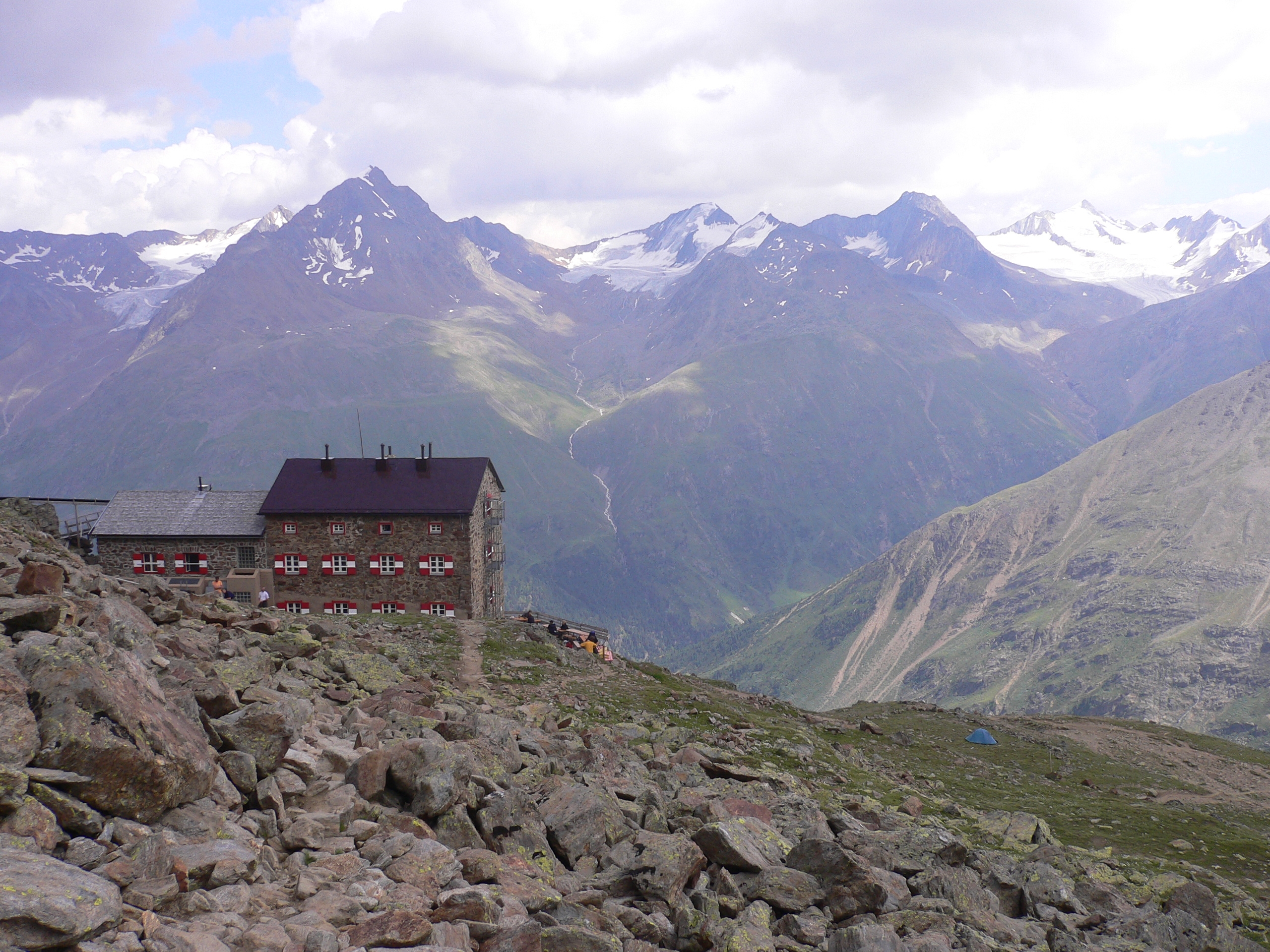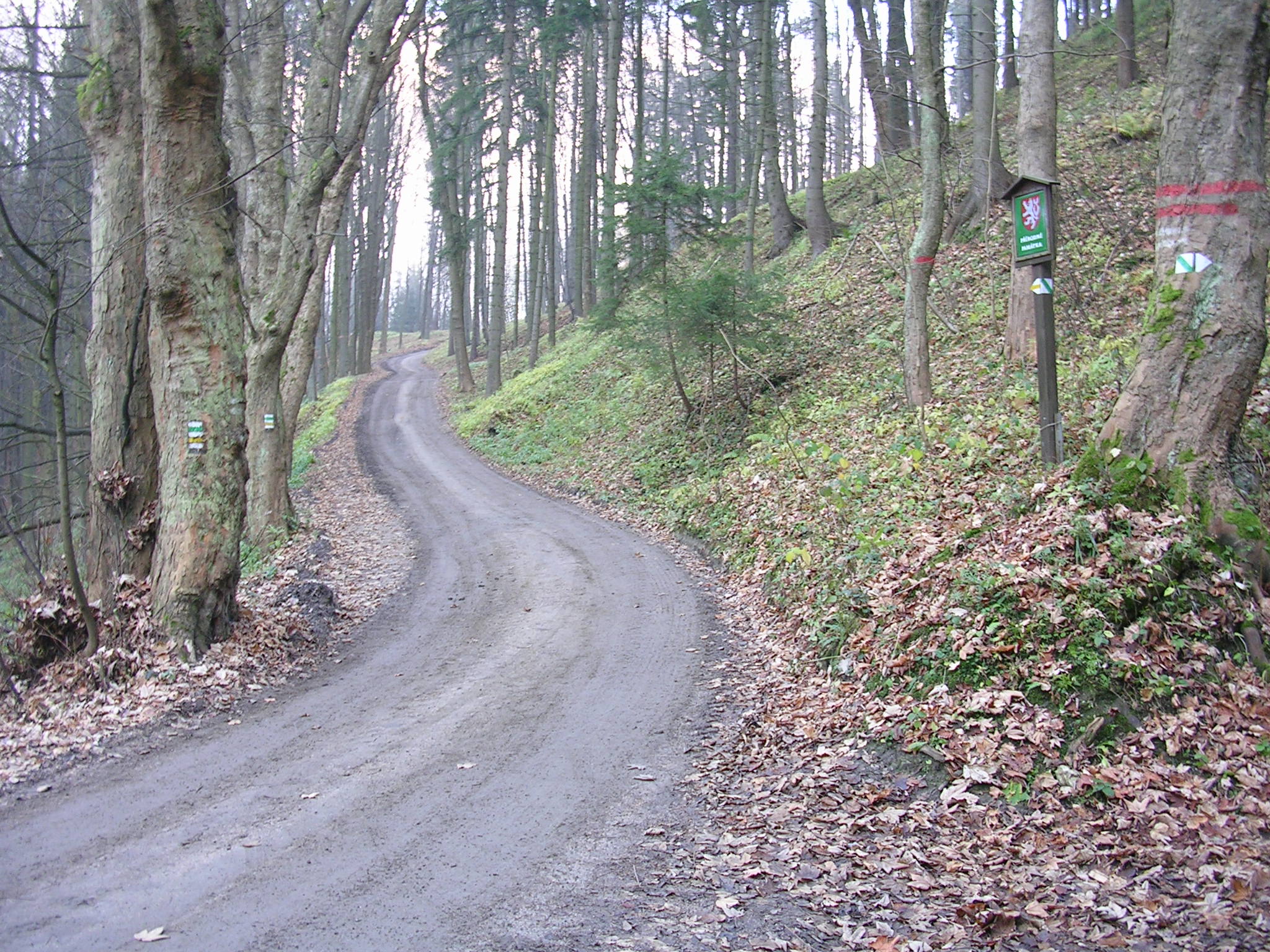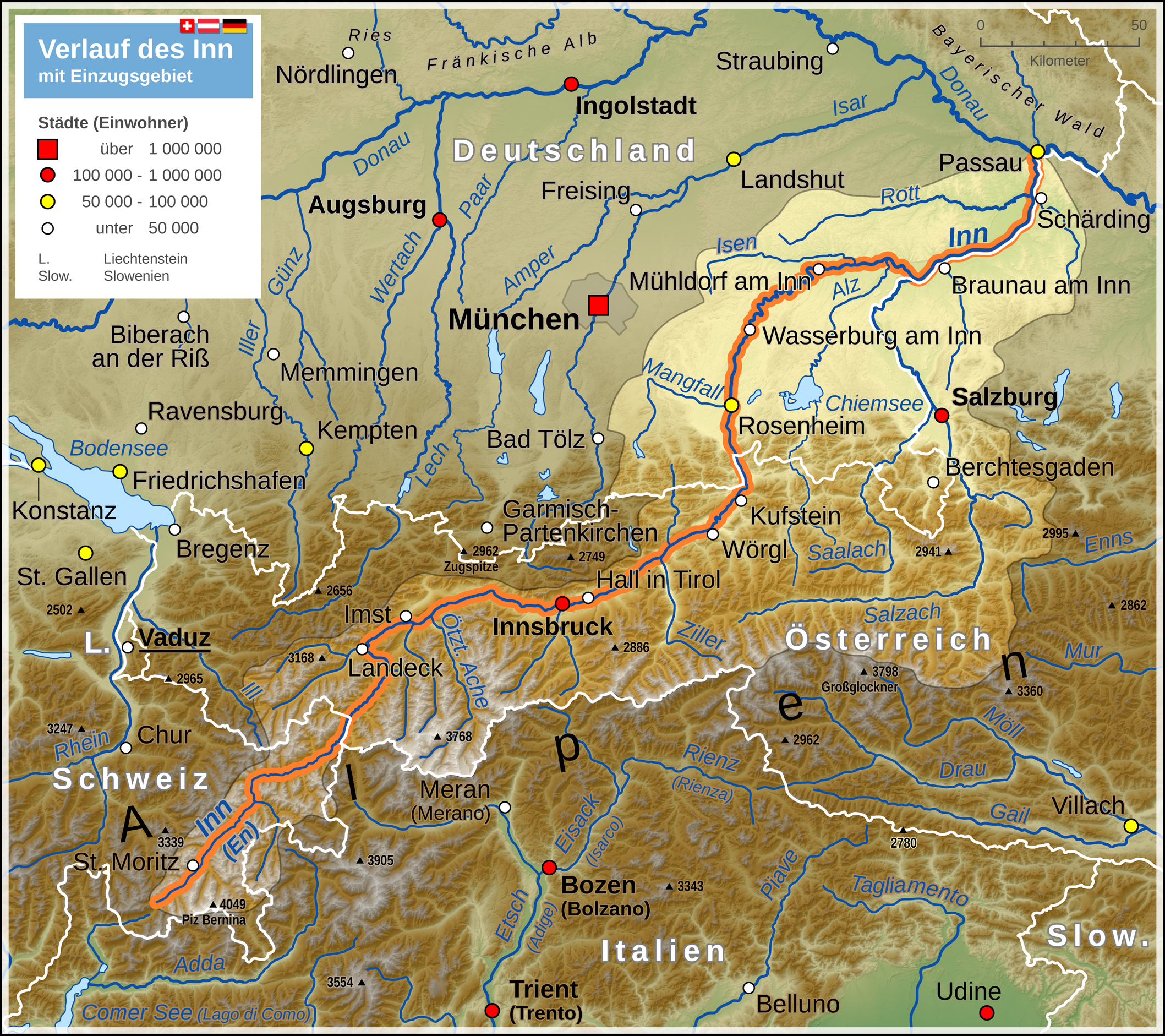|
Walleralm
The Walleralm is an alp with a mountain inn (''Berggasthaus'') that lies at a height of {{Convert, 1170, m, ft above sea level at the foot of the Zettenkaiserkopf, a fore peak of the Zettenkaiser in the Austrian state of Tyrol. The alp is easily and quickly reached by mountain bike or on foot from Lake Hinterstein near Scheffau am Wilden Kaiser along a forest track. The alp has a panoramic view of the Kitzbüheler Horn mountain above the Hohe Salve and across to the Inn valley, in the distance the glaciers of the High Tauern are visible. Facilities The Walleralm inn, run by the Eberwein family from Scheffau am Wilden Kaiser, lies at 1170 m in the Wilder Kaiser nature reserve and has overnighting accommodation for up to 20 people. The alp and the inn are only managed during the summer months. A few metres below the inn is the Stöffl Hut The Stöffl Hut (german: Stöfflhütte) is a very old mountain hut at the foot of the Wilder Kaiser in the Austrian state of Tyrol. [...More Info...] [...Related Items...] OR: [Wikipedia] [Google] [Baidu] |
Stöffl Hut
The Stöffl Hut (german: Stöfflhütte) is a very old mountain hut at the foot of the Wilder Kaiser in the Austrian state of Tyrol.''Stöfflhütte'' at wilderkaiser.info. Retrieved 30 December 2022. Location The hut lies at a height of in an alpine pasture known as the Walleralm. It is an easy stroll from but may also be used as meal stop (''Jausenstation'') for a range of hiking and climbing tours around the Wilder Kaiser.History The S ...[...More Info...] [...Related Items...] OR: [Wikipedia] [Google] [Baidu] |
Wilder Kaiser
The Kaiser Mountains (german: Kaisergebirge, meaning ''Emperor Mountains'') are a mountain range in the Northern Limestone Alps and Eastern Alps. Its main ridges – are the Zahmer Kaiser and south of it the Wilder Kaiser. The mountains are situated in the Austrian province of Tyrol between the town of Kufstein and the town of St. Johann in Tirol. The Kaiser Mountains offer some of the loveliest scenery in all the Northern Limestone Alps.Reynolds, Kev (2005). ''Walking in the Alps'', 2nd ed., Cicerone, Singapore, p. 430, . Divisions The Kaiser Mountains are divided into the Wilder Kaiser or Wild Kaiser chain of mountains, formed predominantly of bare limestone rock, and the Zahmer Kaiser ("Tame Kaiser"), whose southern side is mainly covered by mountain pine. These two mountain ridges are linked by the 1,580-metre-high Stripsenjoch pass, but are separated in the west by the valley of Kaisertal and in the east by the Kaiserbach valley. In total the Kaiser extends for about ... [...More Info...] [...Related Items...] OR: [Wikipedia] [Google] [Baidu] |
Alpine Pasture
Alpine transhumance is transhumance as practiced in the Alps, that is, a seasonal droving of grazing livestock between the valleys in winter and the high mountain pastures in summer (German ' from the term for "seasonal mountain pasture", '). Transhumance is a traditional practice that has shaped much of the landscape in the Alps, as without it, most areas below would be forests. While tourism and industry contribute today much to Alpine economy, seasonal migration to high pastures is still practiced in Bavaria, Austria, Slovenia, Italy, France and Switzerland, except in their most frequented tourist centers. In some places, cattle are taken care of by local farmer families who move to higher places. In others, this job is for herdsmen who are employees of the cooperative owning the pastures. Most Alpine pastures are below ; all are below . The higher regions not suitable for transhumance are known as the High Alps. Etymology The German word ''Alp'' or ''Alm'' (meaning "se ... [...More Info...] [...Related Items...] OR: [Wikipedia] [Google] [Baidu] |
Mountain Inn
A mountain hut is a building located high in the mountains, generally accessible only by foot, intended to provide food and shelter to mountaineers, climbers and hikers. Mountain huts are usually operated by an Alpine Club or some organization dedicated to hiking or mountain recreation. They are known by many names, including alpine hut, mountain shelter, mountain refuge, mountain lodge, and mountain hostel. It may also be called a refuge hut, although these occur in lowland areas (e.g. lowland forests) too. Mountain huts can provide a range of services, starting with shelter and simple sleeping berths. Some, particularly in remote areas, are not staffed, but others have staff which prepare meals and drinks and can provide other services, including providing lectures and selling clothing and small items. Mountain huts usually allow anybody to access their facilities, although some require reservations. While shelters have long existed in mountains, modern hut systems date back ... [...More Info...] [...Related Items...] OR: [Wikipedia] [Google] [Baidu] |
Lake Hinterstein
Hintersteiner See is a mountain lake in the Wilder Kaiser Austrian national park and belongs to the administrative region of Scheffau in the Austrian federal state of Tirol. The , lake was created during the last ice age and is at a height of 883 m AA. Underground springs fill the lake with crystal-clear water. Hintersteiner See is privately owned by the Tiroler Wasserkraft AG and is cautiously used to generate electricity. It drains into the Weißache river. There is a public bathing beach on the lake. The legend of Hintersteiner See In Hinterstein, there lived some high-spirited, wealthy farmers, who used to play bowls with lumps of butter on their luscious meadow, which was where the Hintersteiner See is today. It was a brightly moonlit night as they played once more. Then suddenly, the earth heaved beneath their feet and they sank with their farm and everything on it into the depths. For their wanton behaviour however, the farmers were banished onto the Scheff ... [...More Info...] [...Related Items...] OR: [Wikipedia] [Google] [Baidu] |
Scheffau Am Wilden Kaiser
Scheffau am Wilden Kaiser is a municipality in the district Kufstein in the Austrian region of the Sölllandl. It is located 8.50 km southeast of Kufstein and 13 km northwest of Kitzbühel Kitzbühel (, also: ; ) is a medieval town situated in the Kitzbühel Alps along the river Kitzbüheler Ache in Tyrol, Austria, about east of the state capital Innsbruck and is the administrative centre of the Kitzbühel district (). Kitzbühel ... and has three subdivisions. The main source of income is summer tourism. The village has a public swimming area. Located just outside Scheffau is the Hintersteiner See, the largest lake in the Wilder Kaiser valley. Lifts It has connections to the larger ' SkiWelt' ski area. These are an 8-man and a 4-man gondola lift. The Scheffau ski area is in the middle of the SkiWelt. References External links Official website Kaiser Mountains Cities and towns in Kufstein District {{Tyrol-geo-stub ... [...More Info...] [...Related Items...] OR: [Wikipedia] [Google] [Baidu] |
Forest Track
Forest tracks or forest roads are roads or tracks intended to carry motorised vehicles or horse-drawn wagons being used mainly or exclusively for forestry purposes, such as conservation or logging. Forest tracks may be open to ramblers or mountain bikers depending on local rules. Description Forest roads may be tarmacked, gravelled or metalled (using hard core) and often have restrictions on use. In many regions the establishment of forest roads is not only subject to approval under forest management law, but also conservation law. in Tyrol retrieved 28 June 2010 In and other especially important conservation areas, forest roads and tracks are generall ... [...More Info...] [...Related Items...] OR: [Wikipedia] [Google] [Baidu] |
Kitzbüheler Horn
The Kitzbüheler Horn (also spelt Kitzbühler Horn) is a mountain in the Kitzbühel Alps in Tyrol, Austria, whose western flank lies near the smart ski resort of Kitzbühel. With a height of it only just misses being a 'two-thousander'. At the summit is a 102 metre high TV tower belonging to the ORF and known as the Kitzbüheler Horn Transmission Tower (''Sendeturm Kitzbüheler Horn''). The ''Harschbichl'' (1,604 m) is a sub-peak to the north which is also accessible. Tourism The mountain has several cable cars and gondola lifts and there is a panoramic toll road from Kitzbühel. There are also several mountain inns on its slopes. The so-called ''Alpenhaus'' (,''Alpenhaus'' at www.alpenhaus.at. Austri ... [...More Info...] [...Related Items...] OR: [Wikipedia] [Google] [Baidu] |
Hohe Salve
The Hohe Salve is a well-known mountain located between Kufstein, Wörgl and Kitzbühel in the Austrian state of Tyrol. It is part of the Kitzbühel Alps and is also nicknamed ''the Rigi of the Tyrol''. Its summit is high,Austrian Map online 1:50.000 (ÖK 50) by the BEV and in fine weather has a good view of the and , as well as the |
Inn Valley
The Inn ( la, Aenus; rm, En) is a river in Switzerland, Austria and Germany. The river is long. It is a right tributary of the Danube and it is the third largest tributary of the Danube by discharge. The highest point of its drainage basin is the summit of Piz Bernina at . The Engadine, the valley of the En, is the only Swiss valley whose waters end up in the Black Sea (via the Danube). Etymology The name Inn is derived from the old Celtic words ''en'' and ''enios'', meaning ''water''. In a document of 1338, the river was named ''Wasser'' (German for water). The first written mention from the years 105 to 109 (Publii Corneli Taciti historiarium liber tertius) reads: "''... Sextilius Felix... ad occupandam ripam Aeni fluminis, quod Raetos Noricosque interfluit, missus...''" ("... Sextilius Felix was sent to capture the banks of the Inn, which flows between the Rhaetian people and the Noric people.") The river is also mentioned by other authors of the Roman Empire as ''Ainos'' (G ... [...More Info...] [...Related Items...] OR: [Wikipedia] [Google] [Baidu] |
High Tauern
The High Tauern (pl.; german: Hohe Tauern, it, Alti Tauri) are a mountain range on the main chain of the Central Eastern Alps, comprising the highest peaks east of the Brenner Pass. The crest forms the southern border of the Austrian states of Salzburg, Carinthia and East Tyrol, with a small part in the southwest belongs to the Italian province of South Tyrol. The range includes Austria's highest mountain, the Grossglockner at above the Adriatic. In the east, the range is adjoined by the Lower Tauern. For the etymology of the name, see Tauern. Geography According to the Alpine Club classification of the Eastern Alps, the range is bounded by the Salzach valley to the north (separating it from the Kitzbühel Alps), the Mur valley and the Murtörl Pass to the east (separating it from the Lower Tauern), the Drava valley to the south (separating it from the Southern Limestone Alps), and the Birnlücke Pass to the west (separating it from the Zillertal Alps). Its most imp ... [...More Info...] [...Related Items...] OR: [Wikipedia] [Google] [Baidu] |
Mountain Huts In Tyrol (state)
A mountain is an elevated portion of the Earth's crust, generally with steep sides that show significant exposed bedrock. Although definitions vary, a mountain may differ from a plateau in having a limited summit area, and is usually higher than a hill, typically rising at least 300 metres (1,000 feet) above the surrounding land. A few mountains are isolated summits, but most occur in mountain ranges. Mountains are formed through tectonic forces, erosion, or volcanism, which act on time scales of up to tens of millions of years. Once mountain building ceases, mountains are slowly leveled through the action of weathering, through slumping and other forms of mass wasting, as well as through erosion by rivers and glaciers. High elevations on mountains produce colder climates than at sea level at similar latitude. These colder climates strongly affect the ecosystems of mountains: different elevations have different plants and animals. Because of the less hospitable terrain and ... [...More Info...] [...Related Items...] OR: [Wikipedia] [Google] [Baidu] |




